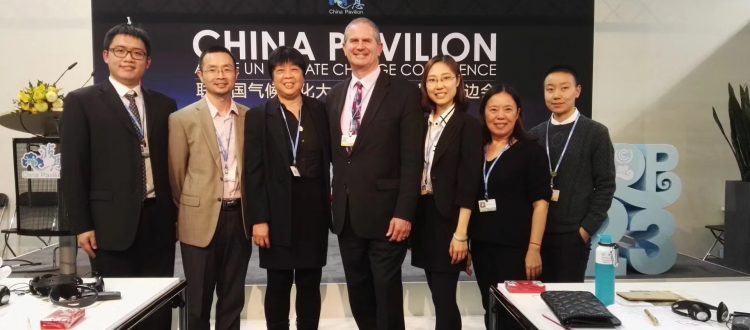GEI Insight: South-South Cooperation to Fight Climate Change
International efforts to mitigate climate change continue to progress following signing of the Paris Climate Agreement. However, two main issues remain at the forefront of climate governance activity, establishing strong green finance mechanisms and supporting developing countries’ to reach their low-carbon goals.
China is working to do its part to address these two issues through China’s South-South Cooperation for Climate Change, which President XI announced the at the COP21 in Paris in 2015. So far China has pledged $3.1 billion for the Fund and signed partnerships with over 27 nations [3] [4].
In addition to funds, China’s South-South Cooperation for Climate Change leverages Chinese renewable energy technology aid and expert knowledge. GEI has been working to build up the capacity for the Chinese government to facilitate in-kind aid and support sustainable development abroad for several years, and at this year’s COP23, we highlighted our latest work in Sri Lanka!
China’s South-South Climate Cooperation in Action: Myanmar
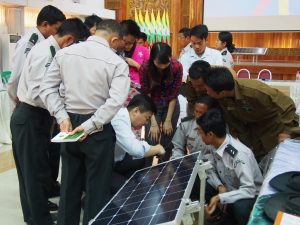
Chinese experts showing officials from Myanmar a solar panel at South-South Cooperation signing event. Photo: GEI 2017
GEI’s renewable energy pilot project in Myanmar successfully facilitated $2.9million USD of China’s South-South Climate Cooperation from the NDRC to Myanmar. This in-kind aid went to purchase 10,000 cook stoves and 5,000 solar panels for rural villages in Myanmar [4]. The technology has already been introduced to 16 other villages in Myanmar via GEI’s successful project design.
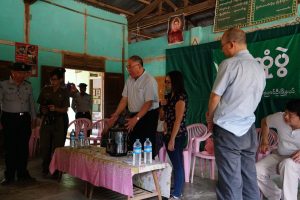
Xie Zhenhua (NDRC) presenting cookstoves in Myanmar. Photo: GEI 2017
South-South Climate Cooperation in Action: Belt and Road
This year, GEI continued to devise projects that could unite China’s South-South Climate Cooperation Fund and its Going Out agenda.
Sri Lanka is a key node on China’s Belt and Road, and in addition to massive infrastructure investment, there is an opportunity to provide climate and development aid. In fact, Sri Lanka pledged to reduce its greenhouse gas emissions by 20% by 2030, but, as of early 2017, only 4% of power came from renewable sources [5].
In 2015 GEI started working with Sri Lanka’s Mahaweli Ministry of Development and Environment to see if it was possible to establish a low-carbon demonstration town in Sri Lanka. This town would serve as a case study of how cities can integrate green technologies into their existing plans and become eco-friendly.
GEI’s Low-Carbon Development Town – Gampola Town, Sri Lanka
Quick-Facts about Gampola Town:
Gampola is located in between Sri Lanka’s key tourism cities and has a population of about 50,000 people.
Project Implementers:
GEI, Sri Lanka Mahaweli Ministry of Environment & Development
How it leverages South-South Cooperation:
GEI, as a Chinese NGO, is working with Sri Lanka’s government and local community to build up resilience to climate change and install renewable energy that can support sustainable development. We also helped bring Chinese experts to assess the Gampola and offered trainings for Sri Lankan ministers.
Our Work:
After conducting desk research on renewable energy equipment and Sri Lanka’s unique environmental situation, we went into the field. Using geographic information system (GIS) technology, we mapped and measured how much and which renewable energy technology could be installed where in Gampola town to yield the best results.

Source: GEI 2017
Our Tool:
To demonstrate that the low-carbon way is also the best economic way forward, we used another tool called the R enewable Energy Implementation Toolkit, which we developed with Center for Climate Strategies.
The Toolkit conducts macro & micro-economic cost-benefit analysis of installing renewable energy technology. Essentially, the toolkit can concretely show that by installing X amount of solar energy, the town can gain Y money and Z renewable energy.
Findings:
– Solar lights strategically located over 22,670m2 can accumulate about 2.0MW. The solar lights should be placed on the rooftops of schools, bus stations and train stations
– Mixed-source biomass power can accumulate nearly 5.50MW;
– Green travel – including electric cars and tuk-tuks, plus charging stations – can support local and national development
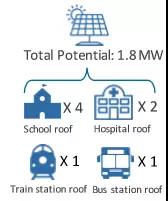
Source: GEI
Next Steps:
The implementation process will begin at end of 2017; GEI will continue to support China-Sri Lanka South-South Climate Cooperation, and help both parties find win-win solutions.
South-South Cooperation Takes COP23
The GEI cohort was busy in Bonn, Germany!
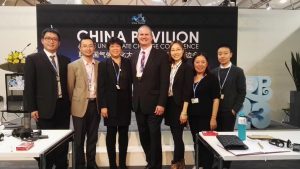
GEI Executive Director Jin Laoshi, Xie Zhenhua (NDRC), and GEI Steering Board Chair, Dr. Ziqiang Zhang. Photo: GEI 2017
On November 9, 2017, GEI co-organized a side event at the China Pavilion with the Institute of Energy, and The Nature Conservancy.The side-event presented the status of China’s renewable energy development, practical experience of using new models and tools, and how these tools have been applied in China and Sri Lanka. More than 110 participants attended the conference, including more than 40 foreign guests from various countries and agencies. In addition to this side event, GEI & CCS was also invited by NDRC to share about the Sri Lanka Gampola Town on Saturday, November 11!
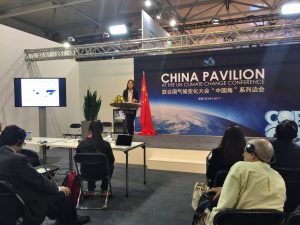
GEI Energy and Climate Change Program Manager Qingchan YU speaking at China Pavilion at COP23. Photo: GEI 2017
On November 12, GEI also spoke at a side event at the South Africa pavilion alongside CCS, GIEC and a representative from Cote Divoire.Together we discussed the Renewable Energy Implementation Toolkit, it’s development and application, as well as potential to leverage more renewable energy in Africa! China’s South-South Climate Cooperation program and climate finance were also discussed by the speakers and participants.
[3] http://www.chinadaily.com.cn/world/XiattendsParisclimateconference/2015
11/30/content_22557413.htm
[4] https://www.chinadialogue.net/article/show/single/en/9701-China-s-climate-aid-flows-into-Myanmar
[5] Sri Lanka Mahaweli Ministry of Environment and Development

